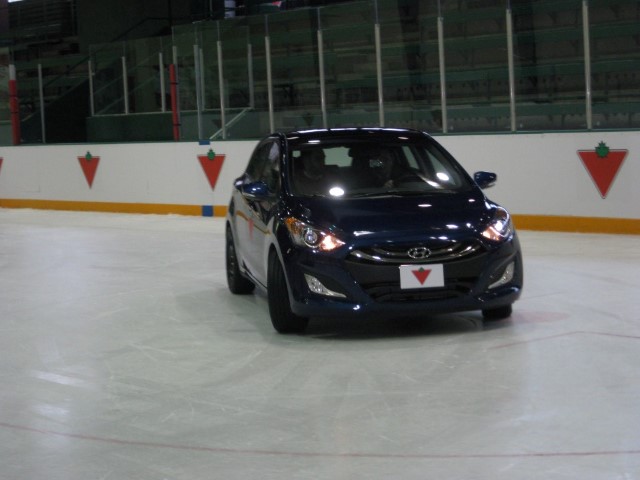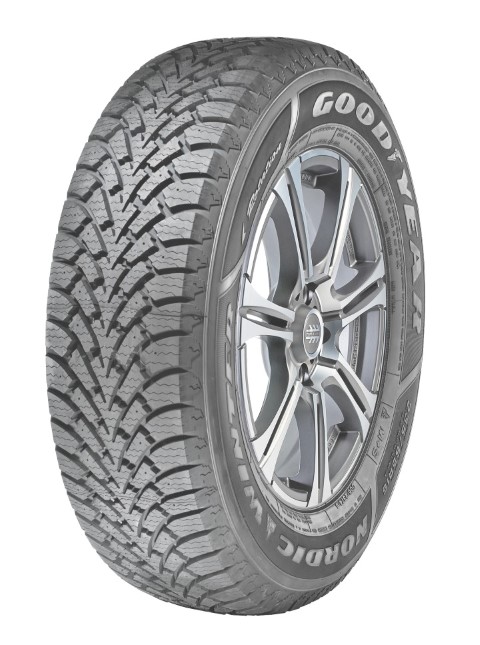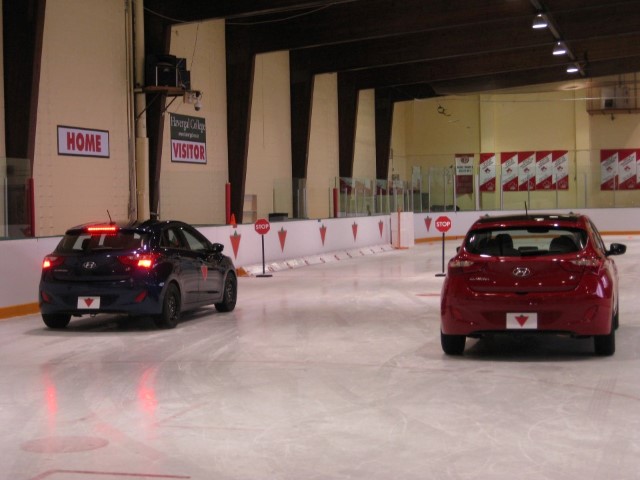Do you think you need winter tires?
- Written by
- Published in News
- font size decrease font size increase font size
- Be the first to comment!
With the first snowfall around the corner, it’s that time again where we brace ourselves for the cold and buy a new winter coat and boots. Some of us might like to hibernate in the winter time when we can, but others are most adventurous and most have to at least commute to work – this is where the all-season versus winter tire debate begins.
 Recently I was invited to a winter vehicle preparation clinic hosted by Canadian Tire. It was a chance to showcase their new automotive winter products and learn first-hand how all-season and winter tires perform on a local hockey rink.
Recently I was invited to a winter vehicle preparation clinic hosted by Canadian Tire. It was a chance to showcase their new automotive winter products and learn first-hand how all-season and winter tires perform on a local hockey rink.
Safety should always be paramount whenever you use your vehicle, but I don’t believe people understand the vast differences between the two types of tires. All-season is a catchy name that can make a driver feel safe, but when it comes to winter driving the softer compound on winter tires retains elasticity giving you much more control and traction. While, all-season tires tend to harden at 7 Celsius and lose their grip.
 The decision is clearly not just based on which is better – if that was the case everyone would have winter tires, but whether it’s worth it to buy. Winter tires can be a large investment for some, which would double their cost for tires and add extra charges for making the tire switch twice a year. It’s an individual or family choice and it should be based on how often you use your vehicle and what you use it for. If you use your car very sparingly – I might say it’s not worth it to make the winter tire investment, but if you do travel a sizeable distance or like to drive in the winter time – the Canadian Tire hockey rink experience might help you with your decision.
The decision is clearly not just based on which is better – if that was the case everyone would have winter tires, but whether it’s worth it to buy. Winter tires can be a large investment for some, which would double their cost for tires and add extra charges for making the tire switch twice a year. It’s an individual or family choice and it should be based on how often you use your vehicle and what you use it for. If you use your car very sparingly – I might say it’s not worth it to make the winter tire investment, but if you do travel a sizeable distance or like to drive in the winter time – the Canadian Tire hockey rink experience might help you with your decision.
The two tires being tested were the MotoMaster SE2, Canadian Tire’s best-selling all-season and Goodyear’s Nordic Winter Tire, designed specifically for life in Canada. I was told before beginning that modern winter tires offer up to 50% - or even more – winter traction than all-season tires by Graham Jeffery, Category Business Manager at Canadian Tire. These sets of tires were placed on identical Hyundai Elantra GT’s and they were tested through various skating rink routes and stops.
Now it was time to see for myself…
I started with the blue Elantra GT which had the Goodyear Nordic Winter tires on it. It cornered well around the rink, but not too much throttle could be used as I began to head straight for the hockey boards. With an ease off of the accelerator and a steering wheel rotation in the opposite direction (counter-clockwise) I was back on track and feeling safe. After numerous laps and slopes it was time to test out the brakes. A stop sign was situated just ahead of a large measuring tape in ft. I slowly accelerated up to 15 km and slammed the brakes at the stop sign finally coming to a complete stop 21 ft. away.
 Now it was time for the comparison as I jumped into the red Elantra GT with the all-season MotoMaster SE2’s. I felt the difference immediately as I tried to glide it up to 15 km, which was a struggle. The harder compound rubber failed to get any traction for my turn and that was my indication to slow down. I didn’t feel the same comfort level while driving and was overly cautious with any acceleration. As for the braking test – well it took an extra 14 ft. to stop as I landed on 35 ft. away from the stop sign.
Now it was time for the comparison as I jumped into the red Elantra GT with the all-season MotoMaster SE2’s. I felt the difference immediately as I tried to glide it up to 15 km, which was a struggle. The harder compound rubber failed to get any traction for my turn and that was my indication to slow down. I didn’t feel the same comfort level while driving and was overly cautious with any acceleration. As for the braking test – well it took an extra 14 ft. to stop as I landed on 35 ft. away from the stop sign.
There are various types of winter tires on the Canadian market, and it's important to assess your needs in order to select the right tire for your kind of driving. The Goodyear Nordic Winter Tire was exceptional compared to the MotoMaster all-season tire and you can only imagine what the difference might be in real road conditions while driving in speeds four times more than I was going. “Goodyear’s Nordic Winter Tire can stop 45 ft. shorter than a regular all-season when traveling at 60 kms,” said Jeffery. The braking gap between the two was eye-opening and if safety is a concern – you better get suited for some winter tires before the first snowfall.

